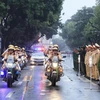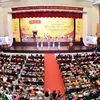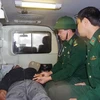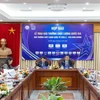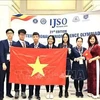About 10,000 Cambodians, who survived Khmer Rouge genocide, gathered in the Democracy Square in Phnom Penh on June 9 to protest against an opposition party leader who allegedly described a notorious Khmer Rouge prison as a Vietnamese invention.
During the protest, Chum May, a survivor and leader of this event, said the historical reality itself totally rejects the tone made on May 18 in Kandal province by Kem Sokha, acting head of the Cambodia National Rescue Party (CNRP).
Kem Sokha said that if the Tuol Sleng prison belonged to the Pol Pot genocidal regime, they must collapse it before withdrawing from Phnom Penh in January 1979.
Protesters voiced their strong support for Chum May’s comments that say Kem Sokha’s words are historical distortion, which seriously offended the souls of three million people who were killed by the Khmer Rouge during 1975-79, including about 20,000 prisoners in the famous notorious Khmer Rouge-run Tuol Sleng prison.
Chum May said the speedy attack of Cambodian and Vietnamese voluntary soldiers to free Phnom Phenh on January 1, 1979, forced the headsmen in Tuol Sleng to run and leave evidence of their savage crime.
The ex-head of the Toul Sleng prison himself had to plead guilty at the Extraordinary Chamber of the Courts in Cambodia (ECCC) and was sentenced to over 30 years’ imprisonment, said Chum May.
He pointed out that other leaders of the prison such as former National Assembly Chairman Nuon Chea and former President Khieu Samphan are still facing the ECCC to testify their personal responsibilities and the crimes committed by the Khmer Rouge.
Following the protest, Chum May led 500 people to the CNRP headquarters to ask Kem Sokha to light incense sticks at the Toul Sleng prison to apologise before the souls of the dead for his offensive, irresponsible words.
Mu Sochun, Secretary-General of the CNRP and some other leaders of the party pledged to send the protesters’ request to Kem Sokha, but declined to comment on Kem Sokha’s response.
The same day, many protests exploded in almost all provinces of Cambodia .
The Toul Sleng prison, which is also known as a “killing field”, used to be a secondary school and now serves as a museum to showcase the genocidal crime of the Khmer Rough.-VNA
During the protest, Chum May, a survivor and leader of this event, said the historical reality itself totally rejects the tone made on May 18 in Kandal province by Kem Sokha, acting head of the Cambodia National Rescue Party (CNRP).
Kem Sokha said that if the Tuol Sleng prison belonged to the Pol Pot genocidal regime, they must collapse it before withdrawing from Phnom Penh in January 1979.
Protesters voiced their strong support for Chum May’s comments that say Kem Sokha’s words are historical distortion, which seriously offended the souls of three million people who were killed by the Khmer Rouge during 1975-79, including about 20,000 prisoners in the famous notorious Khmer Rouge-run Tuol Sleng prison.
Chum May said the speedy attack of Cambodian and Vietnamese voluntary soldiers to free Phnom Phenh on January 1, 1979, forced the headsmen in Tuol Sleng to run and leave evidence of their savage crime.
The ex-head of the Toul Sleng prison himself had to plead guilty at the Extraordinary Chamber of the Courts in Cambodia (ECCC) and was sentenced to over 30 years’ imprisonment, said Chum May.
He pointed out that other leaders of the prison such as former National Assembly Chairman Nuon Chea and former President Khieu Samphan are still facing the ECCC to testify their personal responsibilities and the crimes committed by the Khmer Rouge.
Following the protest, Chum May led 500 people to the CNRP headquarters to ask Kem Sokha to light incense sticks at the Toul Sleng prison to apologise before the souls of the dead for his offensive, irresponsible words.
Mu Sochun, Secretary-General of the CNRP and some other leaders of the party pledged to send the protesters’ request to Kem Sokha, but declined to comment on Kem Sokha’s response.
The same day, many protests exploded in almost all provinces of Cambodia .
The Toul Sleng prison, which is also known as a “killing field”, used to be a secondary school and now serves as a museum to showcase the genocidal crime of the Khmer Rough.-VNA






